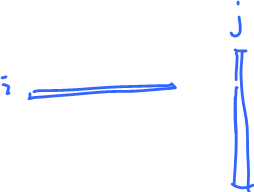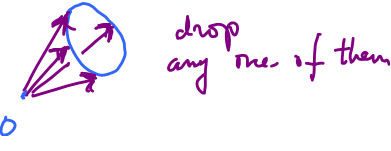This site is being phased out.
Linear algebra: test 1
Test 1 for Linear algebra: course
7 problems, 10 points each
Instructions: Show enough work to justify your answers. Refer to theorems in the book whenever necessary.
- Prove that the set of all non-zero rational numbers, $\mathbf{Q}\backslash \{0\},$ is closed under division.
- Prove that the intersection of two subspaces is always a subspace.
- Prove that the set of all diagonal $n\times n$ matrices, i.e., ones with $a_{ij}=0$ for all $i\neq j,$ is a subspace of $M(n,n).$
- Find the reduced row echelon form of the following system of linear equations. What is the dimension of its solution set? $$x+y-z=1$$ $$x-y+2z=0$$ $$3x+y\;\;\;\;\;=2$$
- Is it possible that a homogeneous system of linear equations has (a) no solutions, (b) one solution, (c) two solutions, (3) infinitely many solutions? Give an example of such a system or explain why it's not possible.
- The set $$\{(2,1,1),(1,2,1),(0,1,1),(1,1,1)\}$$ spans $\mathbf{R}^{3}.$ Use the proof of the Reduction Theorem as a recipe for finding a subset of this set that is a basis of $\mathbf{R}^{3}.$
- Let $$B=\{x-1,x+1\}.$$ (a) Prove that $B$ is a basis of $\mathbf{P}_{1}.$ (b) Find the coordinate vector $[3x-5]_{B.}$
Notes
- 1. ${\bf Q} \setminus \{ 0 \}$, complement (or ${\bf Q} - \{0\}$, same).
$r \in {\bf Q}$, $q \in {\bf Q}$ implies $\frac{r}{q} \in {\bf Q}$.
$r = \frac{a}{b}, q = \frac{c}{d}, a,b,c,d \in {\bf Z} \setminus \{ 0\}$ .
- 2.
$a_{ij}=0$, $b_{ij}=0$ if $i \neq j$
- 4.
$$\left[ \begin{array}{ccc|c} 1 & 1 & -1 & 1 \\ 1 & -1 & 2 & 0 \\ 3 & 1 & 0 & 2 \end{array} \right] \rightarrow \left[ \begin{array}{ccc|c} 1 & 0 & -\frac{1}{2} & \frac{1}{2} \\ 0 & 1 & -\frac{3}{2} & \frac{1}{2} \\ 0 & 0 & 0 & 0 \end{array} \right]$$
Reduced row echelon form; dimension is one, this is a line.
$$\left\{ \begin{array}{} x_1 &= \frac{1}{2}x_3 + \frac{1}{2} \\ x_2 &= \frac{3}{2}x_3 + \frac{1}{2} \\ x_3 &= x_3 \end{array} \right. \rightarrow \left[ \begin{array}{} x_1 \\ x_2 \\ x_3 \end{array} \right] = t \left[ \begin{array}{} \frac{1}{2} \\ \frac{3}{2} \\ 1 \end{array} \right] + \left[ \begin{array}{} \frac{1}{2} \\ \frac{1}{2} \\ 0 \end{array} \right]$$
(Note: the first term on the right hand side of the matrix equations is a vector and the second term is a point.)
This is the solution set, not a subspace because the system is non-homogeneous.
$0$ is not a solution, $0 \not \in S$
(Theorem: Homogeneous system implies $S$ is a subspace.)
- 5.
- a. no solution, no (see theorem above).
- b. one solution, yes
$\left[ \begin{array}{ccc|c} 1 & 0 & 0 & 0 \\ 0 & 1 & 0 & 0 \\ 0 & 0 & 1 & 0 \end{array} \right]$
- c. two solutions, no (see theorem above)
- d. infinitely many, yes (#4)
- 6. Drop one vector.
No need to prove linear dependence, from definition. We know that already because four vectors in ${\bf R}^3$ are linearly dependent.
Which one?
Does it matter? Yes.
Drop $a$, then linearly dependent still, don't span.
Find one that is a linear combination of the rest and remove it.
$$a_1 \left[ \begin{array}{} 2 \\ 1 \\ 1 \end{array} \right] + a_2 \left[ \begin{array}{} 1 \\ 2 \\ 1 \end{array} \right] + a_3 \left[ \begin{array}{} 0 \\ 1 \\ 1 \end{array} \right] = \left[ \begin{array}{} 1 \\ 1 \\ 1 \end{array} \right],$$
solve.
In fact, no need to solve:
$${\rm rank}\left[ \begin{array}{} 2 & 1 & 0 \\ 1 & 2 & 1 \\ 1 & 1 & 1 \end{array} \right]=?$$
- 7.


